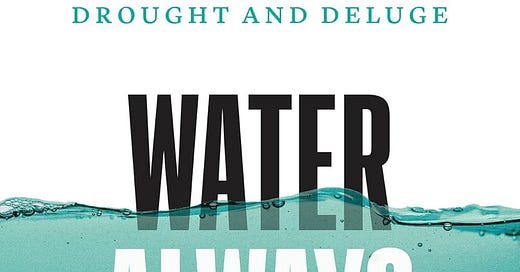I’ve studied and worked in the profession of hydrogeology for over three decades. I’ve learned that groundwater moves very slowly in the ground beneath our feet. The water we get from our wells might have entered the ground decades, centuries, even millennia ago. In order to understand the importance of groundwater, we need to understand how groundwater fits into the water cycle.
Although I learned how water moves through the water cycle many years ago, only recently have I learned to appreciate the importance of the speed at which water moves through its cycle. Groundwater moves at the scale of metres per day, whereas water in streams can flow on the scale of kilometres per day.
To research her book Water Always Wins, journalist Erica Gies travelled around the world to visit communities and cities that have had to deal with issues relating to water. Our instinct for growth has led to cities that have expanded so rapidly, little or no attention has been paid to water issues. In fact, water in streams, wetlands, ponds is typically considered a nuisance. Trenches or channels are built to get rid of water quickly.
By treating water as a nuisance for the benefit of rapid growth, however, Gies notes that humans are working against nature. All water bodies serve a purpose. Wetlands and ponds store water over a long period of time and are important natural features that can aid in flood prevention. They also host many types of wildlife and vegetation. Streams interact with groundwater, which also acts to slow the movement of water. When we pave over land to develop neighbourhoods and parking lots and buildings, we prevent rain from getting into the ground. Instead, we direct the water to sewers. This water then moves to streams very quickly.
Where groundwater once acted to slow water down, human activity has resulted in an increase in “fast flow” or “fast water”. In other words, water gets to creeks and rivers much faster due to urban development. This can lead to flooding of streams that in the past could handle the water from rainfall events because all the water from an event was spread out over a longer period of time1. The premise of Gies’ book is that water needs to move slowly, and this “slow water” has many benefits.
Gies provides many examples of communities she visited where population growth has resulted in environmental damage. However, she selected locations where these communities are re-designing infrastructure such that water behaves in a more natural way. This has led to healthier wetlands, less damage from flooding and healthier ecosystems overall.
As I was reading her book, I found myself hopeful. Over my 30+ year professional career, I’ve developed cynicism about human nature and our disregard for the environment, in favour of economic growth. I was pleasantly surprised to read many examples where communities are being proactive and fixing past mistakes. It takes a lot of hard work and political engagement, but it can be done! I find that my cynicism is slowly shifting towards optimism.
Thanks for reading the Water Droplet! Stay tuned for more interesting articles on water. To get email notifications of new articles, sign up here:
Think of it this way: A stream may be able to handle a flow rate of up to 100 cubic metres per second before flooding occurs. If there’s a high rainfall storm and all the water is directed quickly to the stream, the stream will get a surge of water and the flow rate in the stream may exceeed the 100 cubic-meter-per-second threshold and the stream will flood. In this example, let’s assume the flow rate reaches 100 for 6 hours. But if much of that rainfall is held back in wetlands, ponds and is allowed to get into the groundwater, the release of water to the stream will be slower. So the storm surge might not reach the 100 cubic meter per day threshold. In this example, the flow right might only reach 50, but it would occur over a longer period of time (maybe 12 hours). So groundwater, wetlands, etc., are “flattening the curve”.





I've been meaning to read this book. There a great podcast with the author on this permaculture and ecology podcast
https://open.spotify.com/episode/4eMi3FNhhr2c9QvpKbCp5R?si=fP-tep-qQsq2bBWGl2O3Bg
Thank you 💧💦